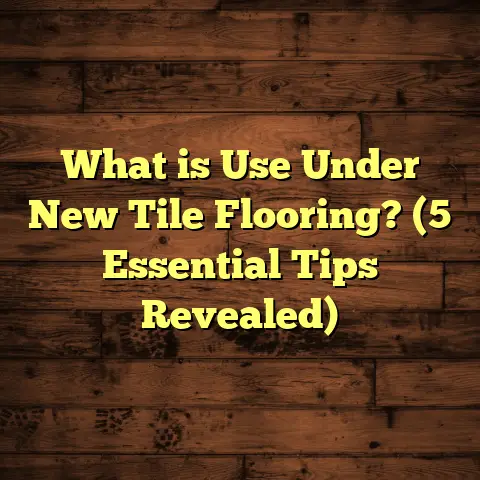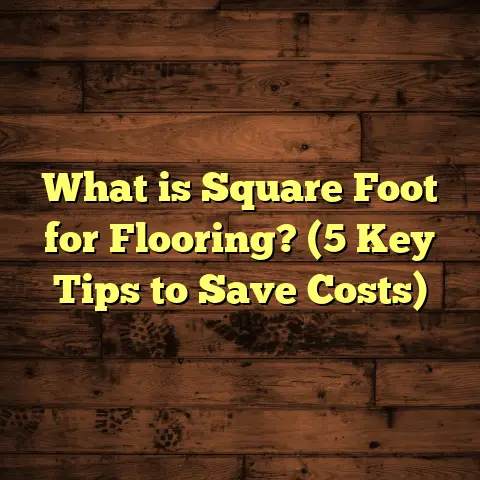What is Floor Underlay for Laminate Flooring? (5 Key Benefits Revealed)
What is Floor Underlay for Laminate Flooring?
Floor underlay is a thin material layer installed between the subfloor—the base surface beneath your floor—and the laminate floor itself. It’s usually made of foam, felt, cork, rubber, or a combination of materials designed to cushion, insulate, and protect your laminate floor.
The thickness of underlay varies. Most commonly, it ranges from 2mm to 6mm thick. Choosing the right thickness depends on several factors: the type of subfloor you have, the kind of laminate flooring you’re installing, and your personal preferences for comfort and soundproofing.
For example, when I worked on a project in Seattle, we used a 6mm foam underlay because the homeowner wanted extra softness and noise reduction. The total area was about 1,200 square feet. The underlay cost around $0.80 per square foot, so the material alone was about $960. Installed professionally, the total cost including labor was closer to $1,500.
Underlay can also include an integrated moisture barrier—a thin plastic sheet that prevents moisture from seeping up into your laminate planks. This is crucial if you’re installing over concrete slabs or in basements where moisture can be a hidden enemy.
So why does this matter? Because the underlay isn’t just something that goes under your floor; it protects your investment and makes your floor feel better every day.
1. Noise Reduction — Make Your Floors Quieter
Have you ever walked across a laminate floor and noticed how loud your footsteps sound? Maybe it echoed through an empty room like a drum? That hollow noise happens because laminate is a hard surface that reflects sound instead of absorbing it.
Floor underlay acts like a sound absorber. It reduces impact noises such as footsteps or dropped objects and muffles hollow sounds that bounce beneath your feet.
In fact, research shows that installing a good quality underlay can reduce sound transmission by up to 25 decibels. To give you an idea: normal conversation is about 60 decibels, while a whisper is around 30 decibels. So this reduction is significant—it’s like turning down the volume on footstep noise from loud to nearly silent.
I remember working on an apartment renovation in New York City where noise complaints were common due to thin floors. We installed a 3mm cork underlay beneath laminate planks, which helped reduce sound transmission significantly. The downstairs neighbor later told me they could barely hear footsteps anymore.
Different types of underlays offer varying levels of sound proofing. Rubber is one of the best at sound absorption but tends to be pricier, often around $1.00 to $1.50 per square foot. Cork is also excellent and eco-friendly, while foam is more affordable but less effective for heavy noise reduction.
2. Moisture Protection — Guard Your Floors Against Damage
Moisture is laminate flooring’s worst enemy. Even tiny amounts of water seeping up from below can cause planks to warp, swell, or separate. If you’re installing over concrete floors—common in basements or ground-level rooms—moisture can be present even if you don’t see it.
That’s why many types of floor underlay come with a built-in moisture barrier—usually a thin polyethylene plastic sheet glued or laminated to the underlay. This barrier blocks moisture from rising up while still allowing the laminate to “breathe” so it doesn’t trap humidity and cause mold.
When I did a basement renovation in Portland, Oregon, using an underlay with a moisture barrier made all the difference. The concrete slab was slightly damp even though it seemed dry on top. Without that barrier, the laminate would have quickly deteriorated.
Cost-wise, underlays with moisture barriers add about $0.20 to $0.50 more per square foot than standard foam types. Considering the potential damage from moisture, this extra investment often saves thousands in future repairs.
If you’re unsure whether your subfloor needs moisture protection, a simple test can help: tape a plastic sheet down for 24-48 hours and check for condensation underneath. If moisture appears, definitely use an underlay with a vapor barrier.
3. Comfort Underfoot — Walk on Clouds
Laminate floors look fantastic but can feel hard and cold without proper cushioning beneath them. Underlay adds softness and comfort by providing a slight cushion when you walk or stand.
Thickness plays a big role here: 4mm to 6mm thick underlays give noticeably more “give” underfoot than thinner layers. Also, denser materials like cork feel softer and warmer compared to basic foam.
I installed a 5mm cork underlay in a yoga studio in Austin once. The owner told me her clients loved how much gentler the floor felt during stretches and poses compared to hardwood or tile floors they used before.
Not only does this comfort reduce fatigue if you stand for long periods—like in kitchens or workshops—but it also improves the overall feel of your home’s interior.
If you’ve ever stood barefoot on laminate without an underlay during winter and thought your feet were freezing, that’s where thermal insulation of the underlay can help as well.
4. Subfloor Imperfection Compensation — Hide Those Bumps
Let’s be honest: very few subfloors are perfectly smooth and level. Small cracks, bumps, or uneven spots are common, especially in older homes with concrete or plywood bases.
Laminate flooring requires a flat surface for proper installation. If your subfloor has irregularities greater than about 3mm over 10 feet, those defects can cause gaps between planks, creaking noises, or even damage over time.
Here’s where underlay shines: it fills minor imperfections by acting like a shock absorber between your subfloor and laminate planks. This cushioning prevents direct stress on joints and helps keep the floor stable.
In one home renovation in Chicago, we encountered concrete slab irregularities of up to 4mm in spots. Using a dense 3-4mm foam underlay allowed us to compensate enough without resorting to expensive leveling compounds.
If your subfloor has serious issues beyond minor bumps—like severe slopes or cracks—you’ll still need professional repair or leveling before installing laminate plus underlay.
5. Thermal Insulation — Warm Feet All Year Round
Cold floors can make walking barefoot uncomfortable during fall and winter months. Underlay acts as an insulating layer between your cold subfloor and warm room air by slowing heat transfer.
This keeps floors feeling warmer longer and can help reduce heating bills slightly since less heat escapes through the floor.
The thermal resistance of an underlay is measured as its R-value—the higher the R-value, the better its insulation properties.
Cork has one of the highest R-values among common underlays—approximately 0.07–0.10 per millimeter thickness—meaning a 5mm cork layer offers an R-value around 0.35–0.50.
Foam underlays have lower R-values but still add some insulation.
In Minneapolis where winters can dip well below freezing for months, I installed cork underlay beneath laminate flooring for a client who noticed their feet stayed warm even during cold snaps.
While not a substitute for proper heating systems or radiant floor heating, adding thermal insulation via underlay improves comfort noticeably.
Extra Insights From My Flooring Projects
Over more than a decade working on hundreds of flooring projects across different climates—from humid Florida to snowy Minnesota—I’ve seen firsthand how essential selecting the right underlay is.
Here are some tips I always share with clients:
Follow Manufacturer Guidelines
Some laminate brands specify minimum or maximum thicknesses and types of underlay allowed without voiding warranties. Always check product documents before buying materials.
Installation Time and Process
Laying underlay for an average-sized room (around 1,000 square feet) usually takes about 1 to 2 hours for professionals once the subfloor is clean and dry.
Underlay generally comes in rolls or sheets that you unroll and tape together at seams to create a continuous layer before laying laminate planks on top.
Waste Factor
Expect around 5-10% extra material for cutting around corners, doorways, and odd shapes—plan quantity accordingly when ordering supplies.
DIY Friendly But Watch Out
Installing underlay is straightforward enough for most DIYers; however, if your subfloor has serious flaws like cracks or unevenness beyond what underlay can fix, consider consulting pros first.
Regional Cost Differences
Material prices vary widely by location due to availability and shipping costs. For instance:
- In New York City metro area: Foam underlay costs about $0.80–$1.20 per sq ft
- In Midwest cities like Chicago: Prices closer to $0.50–$0.90 per sq ft
- In rural areas: Could be slightly cheaper but fewer options available locally
Labor rates also differ substantially depending on local market conditions—from $1–$3 per sq ft for installation depending on complexity.
Case Study: Johnson Family Kitchen Makeover in Denver
The Johnson family wanted to replace their outdated vinyl kitchen floor with something stylish yet practical—laminate was their choice due to affordability and look.
They had concerns about occasional spills and cold concrete slabs below since their kitchen was on ground level.
I recommended:
- Laminate flooring at $3.50 per sq ft
- A quality 4mm foam underlay with integrated moisture barrier at about $0.75 per sq ft
- Professional installation at $1.50 per sq ft
The kitchen area was roughly 200 square feet:
| Item | Cost per sq ft | Total Cost |
|---|---|---|
| Underlay | $0.75 | $150 |
| Laminate flooring | $3.50 | $700 |
| Installation labor | $1.50 | $300 |
| Total | $1,150 |
Post-installation feedback:
- The Johnsons noticed significantly quieter footsteps.
- The floor felt warmer on cold mornings.
- Cleaning was easier than their old vinyl.
- They were impressed by how durable it seemed after several months of daily use.
This example shows how selecting the right underlay tailored to specific conditions adds value beyond just aesthetics.
How to Choose the Right Underlay for Your Project?
Now that you know why underlays matter so much, how do you pick what’s best for your floor?
Here’s what I suggest:
Step 1: Identify Your Subfloor Type
- Concrete requires moisture barrier protection.
- Wooden subfloors may only need cushioning and soundproofing.
- Uneven subfloors benefit from thicker or denser underlays for leveling effects.
Step 2: Consider Your Usage
- High-traffic areas should have durable, dense materials.
- Bedrooms or quiet spaces benefit from soundproofing-focused products.
- Rooms prone to moisture need vapor barriers.
Step 3: Decide on Comfort Level
If you want softer floors for standing or walking barefoot often, opt for thicker cork or foam types around 5-6mm thick.
Step 4: Factor in Budget
Underlays range from budget-friendly foam ($0.30–$0.70/sq ft) to premium cork/rubber ($1+ per sq ft).
Step 5: Confirm Warranty Requirements
Check if your laminate brand requires specific types or thicknesses of underlay so you don’t lose coverage.
Materials Breakdown: Pros & Cons of Popular Underlays
| Material | Thickness Range | Cost (per sq ft) | Noise Reduction | Moisture Barrier | Cushioning | Thermal Insulation | Best For |
|---|---|---|---|---|---|---|---|
| Foam | 2–6 mm | $0.30 – $0.80 | Moderate | Optional | Moderate | Low | General use, budget projects |
| Cork | 3–6 mm | $0.80 – $1.50 | High | Usually no | High | High | Soundproofing & comfort |
| Rubber | 3–5 mm | $1 – $1.50+ | Very High | Usually no | High | Medium | Noise-sensitive areas |
| Felt | 3–5 mm | $0.50 – $1 | Moderate | Optional | Moderate | Medium | Moderate insulation needs |
Each material has unique benefits based on your priorities like soundproofing vs thermal comfort vs cost-effectiveness.
My Personal Story: Why I Never Skip Underlay Anymore
Years ago when I first started installing laminate floors professionally, I thought skipping underlay would save clients money without much downside—after all, laminate looks great by itself!
But after seeing multiple floors start creaking prematurely or warping due to moisture damage within months in clients’ homes who didn’t use proper underlays, I changed my approach completely.
One particular case stuck with me—a young family in Boston who didn’t want to pay extra for underlay over their concrete basement floor installation. Within six months, their laminate started buckling badly due to trapped moisture beneath with no vapor barrier protection.
That experience taught me how crucial proper underlay selection and installation really is—not just for comfort but for protecting the entire flooring investment long-term.
Frequently Asked Questions About Floor Underlay
Q: Can I install laminate flooring without an underlay?
A: While technically possible in some cases (like floating floors over very smooth wood), skipping underlay is generally not recommended as it reduces comfort, soundproofing, and protection against moisture and subfloor imperfections.
Q: How long does an underlay last?
A: Quality underlays last as long as your laminate flooring—typically 15-25 years—if kept dry and properly installed.
Q: Does thicker mean better?
A: Not always; thickness helps with cushioning but density matters more for durability and leveling ability. Check manufacturer recommendations carefully.
Q: Can I reuse old underlay?
A: No; used underlays compress over time losing effectiveness and may harbor mold or dust mites if not properly cleaned.
Q: Is underlay needed for all types of laminate?
A: Most laminate flooring requires some form of underlay; engineered hardwood floors may have different requirements.
Final Thoughts
Remember that floor underlay isn’t just some optional accessory—it’s part of what makes your laminate flooring feel comfortable, stay quiet, last longer, and resist damage from moisture or uneven surfaces.
If you’re planning new flooring soon—whether for a cozy bedroom or busy living room—take time to pick the right underlay based on your space’s needs and budget. You’ll thank yourself every time you walk across that soft yet sturdy floor knowing it was all done right from beneath your feet.
Got questions about flooring projects? Just ask—I’m here to help!




